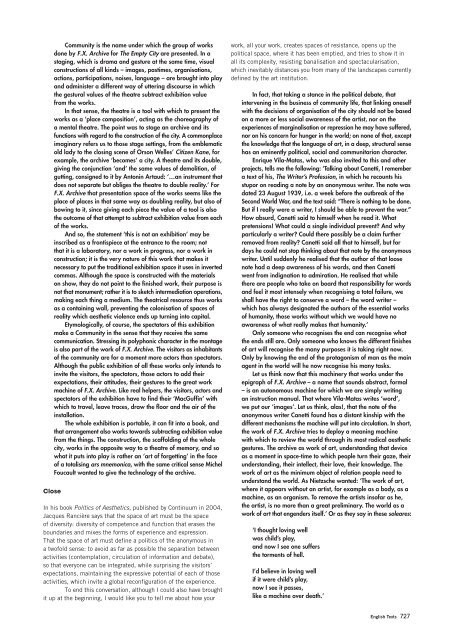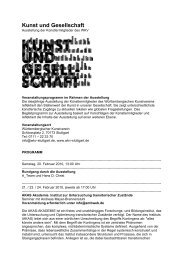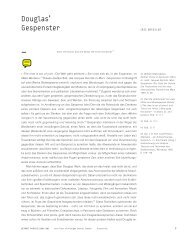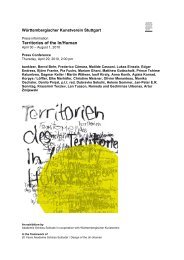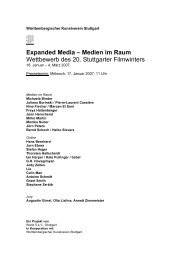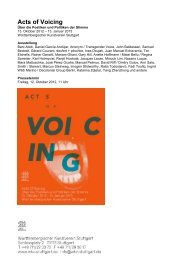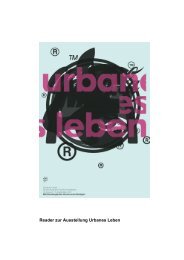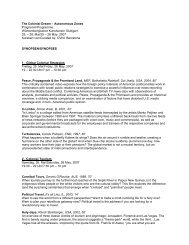English Texts
English Texts
English Texts
Create successful ePaper yourself
Turn your PDF publications into a flip-book with our unique Google optimized e-Paper software.
Close<br />
Community is the name under which the group of works<br />
done by F.X. Archive for The Empty City are presented. In a<br />
staging, which is drama and gesture at the same time, visual<br />
constructions of all kinds – images, pastimes, organisations,<br />
actions, participations, noises, language – are brought into play<br />
and administer a different way of uttering discourse in which<br />
the gestural values of the theatre subtract exhibition value<br />
from the works.<br />
In that sense, the theatre is a tool with which to present the<br />
works as a ‘place composition’, acting as the choreography of<br />
a mental theatre. The point was to stage an archive and its<br />
functions with regard to the construction of the city. A commonplace<br />
imaginary refers us to those stage settings, from the emblematic<br />
old lady to the closing scene of Orson Welles’ Citizen Kane, for<br />
example, the archive ‘becomes’ a city. A theatre and its double,<br />
giving the conjunction ‘and’ the same values of demolition, of<br />
gutting, consigned to it by Antonin Artaud: ‘…an instrument that<br />
does not separate but obliges the theatre to double reality.’ For<br />
F.X. Archive that presentation space of the works seems like the<br />
place of places in that same way as doubling reality, but also of<br />
bowing to it, since giving each piece the value of a tool is also<br />
the outcome of that attempt to subtract exhibition value from each<br />
of the works.<br />
And so, the statement ‘this is not an exhibition’ may be<br />
inscribed as a frontispiece at the entrance to the room; not<br />
that it is a laboratory, nor a work in progress, nor a work in<br />
construction; it is the very nature of this work that makes it<br />
necessary to put the traditional exhibition space it uses in inverted<br />
commas. Although the space is constructed with the materials<br />
on show, they do not point to the finished work, their purpose is<br />
not that monument; rather it is to sketch intermediation operations,<br />
making each thing a medium. The theatrical resource thus works<br />
as a containing wall, preventing the colonisation of spaces of<br />
reality which aesthetic violence ends up turning into capital.<br />
Etymologically, of course, the spectators of this exhibition<br />
make a Community in the sense that they receive the same<br />
communication. Stressing its polyphonic character in the montage<br />
is also part of the work of F.X. Archive. The visitors as inhabitants<br />
of the community are for a moment more actors than spectators.<br />
Although the public exhibition of all these works only intends to<br />
invite the visitors, the spectators, those actors to add their<br />
expectations, their attitudes, their gestures to the great work<br />
machine of F.X. Archive. Like real helpers, the visitors, actors and<br />
spectators of the exhibition have to find their ‘MacGuffin’ with<br />
which to travel, leave traces, draw the floor and the air of the<br />
installation.<br />
The whole exhibition is portable, it can fit into a book, and<br />
that arrangement also works towards subtracting exhibition value<br />
from the things. The construction, the scaffolding of the whole<br />
city, works in the opposite way to a theatre of memory, and so<br />
what it puts into play is rather an ‘art of forgetting’ in the face<br />
of a totalising ars mnemonica, with the same critical sense Michel<br />
Foucault wanted to give the technology of the archive.<br />
In his book Politics of Aesthetics, published by Continuum in 2004,<br />
Jacques Rancière says that the space of art must be the space<br />
of diversity: diversity of competence and function that erases the<br />
boundaries and mixes the forms of experience and expression.<br />
That the space of art must define a politics of the anonymous in<br />
a twofold sense: to avoid as far as possible the separation between<br />
activities (contemplation, circulation of information and debate),<br />
so that everyone can be integrated, while surprising the visitors’<br />
expectations, maintaining the expressive potential of each of those<br />
activities, which invite a global reconfiguration of the experience.<br />
To end this conversation, although I could also have brought<br />
it up at the beginning, I would like you to tell me about how your<br />
work, all your work, creates spaces of resistance, opens up the<br />
political space, where it has been emptied, and tries to show it in<br />
all its complexity, resisting banalisation and spectacularisation,<br />
which inevitably distances you from many of the landscapes currently<br />
defined by the art institution.<br />
In fact, that taking a stance in the political debate, that<br />
intervening in the business of community life, that linking oneself<br />
with the decisions of organisation of the city should not be based<br />
on a more or less social awareness of the artist, nor on the<br />
experiences of marginalisation or repression he may have suffered,<br />
nor on his concern for hunger in the world; on none of that, except<br />
the knowledge that the language of art, in a deep, structural sense<br />
has an eminently political, social and communitarian character.<br />
Enrique Vila-Matas, who was also invited to this and other<br />
projects, tells me the following: ‘Talking about Canetti, I remember<br />
a text of his, The Writer’s Profession, in which he recounts his<br />
stupor on reading a note by an anonymous writer. The note was<br />
dated 23 August 1939, i.e. a week before the outbreak of the<br />
Second World War, and the text said: “There is nothing to be done.<br />
But if I really were a writer, I should be able to prevent the war.”<br />
How absurd, Canetti said to himself when he read it. What<br />
pretensions! What could a single individual prevent? And why<br />
particularly a writer? Could there possibly be a claim further<br />
removed from reality? Canetti said all that to himself, but for<br />
days he could not stop thinking about that note by the anonymous<br />
writer. Until suddenly he realised that the author of that loose<br />
note had a deep awareness of his words, and then Canetti<br />
went from indignation to admiration. He realised that while<br />
there are people who take on board that responsibility for words<br />
and feel it most intensely when recognising a total failure, we<br />
shall have the right to conserve a word – the word writer –<br />
which has always designated the authors of the essential works<br />
of humanity, those works without which we would have no<br />
awareness of what really makes that humanity.’<br />
Only someone who recognises the end can recognise what<br />
the ends still are. Only someone who knows the different finishes<br />
of art will recognise the many purposes it is taking right now.<br />
Only by knowing the end of the protagonism of man as the main<br />
agent in the world will he now recognise his many tasks.<br />
Let us think now that this machinery that works under the<br />
epigraph of F.X. Archive – a name that sounds abstract, formal<br />
– is an autonomous machine for which we are simply writing<br />
an instruction manual. That where Vila-Matas writes ‘word’,<br />
we put our ‘images’. Let us think, alas!, that the note of the<br />
anonymous writer Canetti found has a distant kinship with the<br />
different mechanisms the machine will put into circulation. In short,<br />
the work of F.X. Archive tries to deploy a meaning machine<br />
with which to review the world through its most radical aesthetic<br />
gestures. The archive as work of art, understanding that device<br />
as a moment in space-time to which people turn their gaze, their<br />
understanding, their intellect, their love, their knowledge. The<br />
work of art as the minimum object of relation people need to<br />
understand the world. As Nietzsche wanted: ‘The work of art,<br />
where it appears without an artist, for example as a body, as a<br />
machine, as an organism. To remove the artists insofar as he,<br />
the artist, is no more than a great preliminary. The world as a<br />
work of art that engenders itself.’ Or as they say in these soleares:<br />
‘I thought loving well<br />
was child’s play,<br />
and now I see one suffers<br />
the torments of hell.<br />
I’d believe in loving well<br />
if it were child’s play,<br />
now I see it passes,<br />
like a machine over death.’<br />
<strong>English</strong> <strong>Texts</strong> 727


